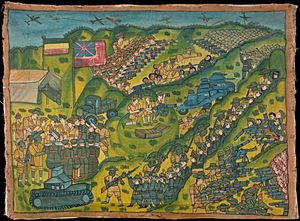Battle of Gondar facts for kids
Quick facts for kids Battle of Gondar |
|||||||||
|---|---|---|---|---|---|---|---|---|---|
| Part of the East African Campaign of the Second World War | |||||||||
 Ethiopian painting of the battle |
|||||||||
|
|||||||||
| Belligerents | |||||||||
|
|||||||||
| Commanders and leaders | |||||||||
| Strength | |||||||||
| 41,000 70 guns 1 aircraft |
2 East African Infantry brigades Camforce (Ethiopian Patriots) Kenya Armoured Car Regiment South African Light Armoured Detachment |
||||||||
| Casualties and losses | |||||||||
| Italian: 407 killed (November 1941), 1,289 killed since June 1940 Ascari: 3,700 killed June–November 1941 Sick and wounded: 8,400 (Italian and Askari) 22,000 prisoners (Italian and Askari) 1 aircraft |
Final assault: 32 killed 182 wounded 6 missing 15 aircraft |
||||||||
The Battle of Gondar was the final major fight for Italian forces in Italian East Africa during the Second World War. This important battle took place in November 1941. It was part of the larger East African Campaign. Gondar was a key town in the mountains of Ethiopia, north of Lake Tana. It was defended by about 40,000 Italian soldiers, led by General Guglielmo Nasi.
Contents
Why Gondar Was Important
After losing battles like the Battle of Keren, many Italian soldiers moved to strongholds such as Amba Alagi, Jimma, and Gondar. Amba Alagi fell in May 1941, and Jimma fell in July. This left Gondar as the last major Italian stronghold.
Gondar was located high up in the mountains, about 7,000 feet (2,100 meters) above sea level. It was a central point for roads, but only one main road was good in all weather. This made it a difficult place to attack. About 70 miles (110 km) from Gondar was a place called Wolchefit. It had a steep road that climbed 4,000 feet (1,200 meters) up a cliff. This made it a strong defensive spot for the Italians.
Preparing for the Battle
To attack Gondar, the Allied forces needed to capture two important mountain passes: Wolchefit and Kulkaber. These passes were like gates to the city.
Taking Wolchefit Pass
Wolchefit was defended by about 4,000 Italian soldiers led by Colonel Mario Gonella. Ethiopian fighters, helped by British Major Ringrose, had been surrounding this stronghold since May 1941. Later, more British and African troops joined the attack. After many fights and running out of food, Colonel Gonella surrendered on September 28, 1941. About 1,600 Italian and 1,400 colonial soldiers were captured.
The Fight for Kulkaber

On November 13, a group of British and Ethiopian troops attacked Kulkaber, another key defensive spot. They were pushed back by the Italian defenders. Kulkaber had been under siege since early September and had faced many attacks.
A second attack on November 21 came from several directions. The Italian soldiers fought hard, but eventually, their positions began to fall. In this final attack, the British and Ethiopians had 206 casualties (killed or wounded). They captured 2,423 Italian and Ethiopian soldiers.
The Last Italian Plane
By this time, the Allies completely controlled the sky. The Italians had only one Fiat CR.42 plane left. It was flown by Sergeant Giuseppe Mottet. On November 22, in the last flight for the Italian air force in East Africa, he attacked British artillery at Kulkaber. He killed a British commander, Lieutenant-Colonel Ormsby. After this brave act, Mottet landed his plane in Gondar, destroyed it so the enemy couldn't use it, and joined the ground troops to continue fighting.
The Battle for Gondar Town
Once the Allied troops took control of the mountain passes, they could see Gondar from above. They reached the town on November 23. The Italian forces in Gondar were much weaker now. Many of their local soldiers, called Askari, had left because they hadn't been paid.
The final attack on Gondar began early on November 27. The first goal was the Azozo airfield, which was captured by midday. Soon after, Commonwealth troops reached Fasilides' Castle, a historic landmark. By 4:30 p.m., British armored cars entered the town. General Nasi sent his last message to Italy, explaining that his reserve troops couldn't stop the attack and that enemy vehicles were already inside the town.
General Nasi surrendered soon after. Some small Italian outposts continued to fight until November 30, but the main battle was over. This marked the end of the Italian presence in East Africa during World War II.
See also
- List of British military equipment of World War II
- List of Second Italo-Ethiopian War weapons of Ethiopia-Arbegnoch used Ethiopian and captured Italian weapons.
- East African Campaign (World War II)
- List of military engagements of World War II
- Unatù Endisciau
- List of Italian Army equipment in World War II


